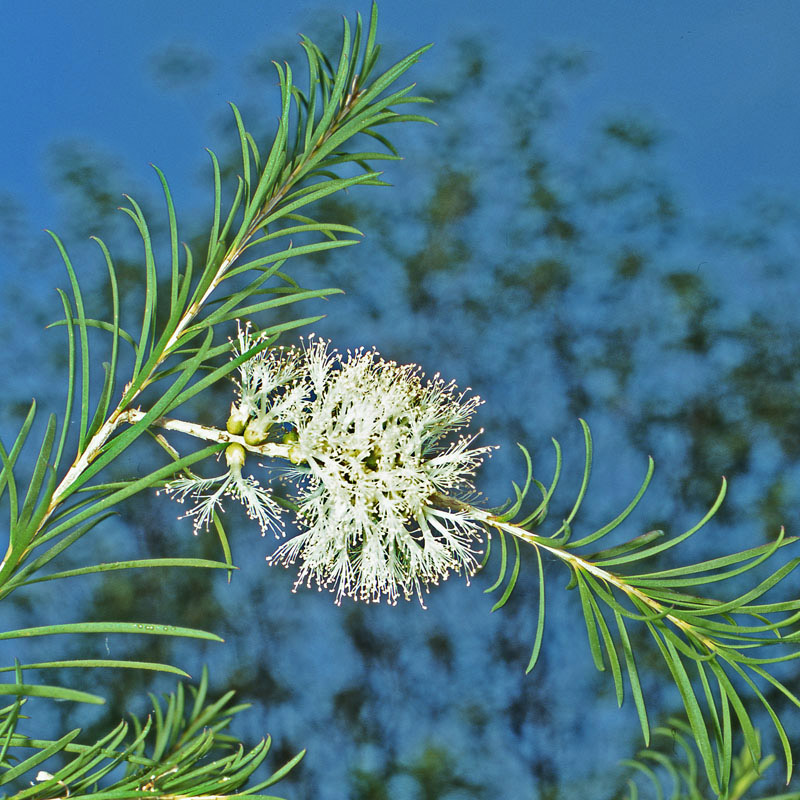Botanical name
Melaleuca alternifolia (Maiden & Betche) Cheel
Family
Myrtaceae
Common name
Tea tree
Information about the plant
The name ‘tea tree‘ was coined in 1770 by naturalist Joseph Banks, who accompanied James Cook aboard the ‘HNS Endeavour’ on his first expedition to the South Seas. Due to a lack of real tea (Camellia sinensis), the ship’s crew brewed an alternative drink from the leaves of the available shrubs and trees, which they called ‘tea trees’ thereafter. These included species of the genera Baeckea, Kunzea, Leptospermum, and Melaleuca. The term ‘tea tree oil’ is broadly used for the essential oils from these four genera; ‘Australian tea tree oil’ always refers to Melaleuca alternifolia. However, other plants that are permitted as derived from Australian tea tree oil include the frost-hardy M. linariifolia Smith and the common inland M. dissitiflora F. Muell.
The main area of distribution of the Australian tea tree (Melaleuca alternifolia) is located in the Subtropical region of Australia between 32° and 27° latitude. The commercial cultivation areas are mainly in the North of South Wales, in the region around the Bungawalbin Basin and extend to the south of Queensland. The Australian tea tree prefers humid locations alongside watercourses or swampy areas. Tea tree oil production is an important economic factor in Australia. Tea tree cultivations can also be found in India, Zimbabwe and South Africa.
The Australian tea tree is a tree that can grow up to 7 m high, has a bushy crown and paper-like, white bark, to which the genus name Melaleuca, derived from the Greek ‘melas’ (= black) and ‘leucos’ (= white), refers. The approximately 2.5 cm long leaves are pointed-lanceolate, sometimes slightly crescent-shaped, and sit opposite to each other on the branches. The numerous white flowers are presented in 5 cm long spikes; the 2 cm long clusters, each consisting of several stamens, form fluffy white masses, that make the inflorescence resemble bottle brushes.
Medicinally used parts of plants (herbal drug)
The essential oil (Melaleucae aetheroleum – tea tree oil) is obtained from leaves and branch tips by steam distillation.
90 % of the oil is supplied from Australia.
Constituents of the herbal drug
Tea tree oil contains numerous monoterpenes, the main components of the oil are terpinen-4-ol, γ-terpinene, α-terpinene and 1,8-cineole.
Quality of the drug
The quality of tea tree oil (Melaleucae aetheroleum) is specified in the European Pharmacopoeia (Ph. Eur.)
Medical applications
Recognised medical use
The HMPC has classified tea tree oil as a traditional herbal medicinal product (see “Traditional Use”).
ESCOP: for bacterial infections and cutaneous mycoses including furunculosis, athlete’s foot, nail fungus and dandruff; for the eradication of MRSA (methicillin-resistant Staphylococcus aureus) during hospitalization; vaginal infections such as Trichomoniasis, vaginal candidiasis and cervicitis.
Traditional use
Tea tree oil has been classified by the HMPC as a traditional herbal medicinal product (§ 39a AMG). Based on many years of experience, tea tree oil can be used to treat small superficial wounds and insect bites as well as small boils (furuncles, acne).
Herbal drug preparations in finished dosage forms
Tea tree oil as an oily solution in liquid and semisolid preparations.
Dosage
Finished dosage form: see patient information leaflet.
Liquid preparations containing 0.5 % to 10 % of essential oil should be applied on the affected area 1–3 times daily. For applications to the affected skin areas using a dressing impregnated with 0.7–1 ml of essential oil stirred in 100 ml of lukewarm water. For rinse or gargle, 0.17–0.33 ml of essential oil mixed in 100 ml of water several times a day.
Preparation of a tea
Not applicable
Notes
Tea tree oil must not be ingested or inhaled; furthermore, it must not come into contact with eyes and ears or applied on burned skin.
The safety of tea tree oil during pregnancy and lactation has not yet been established; the use in children under 12 years is not recommended due to lack of data.
Side effects
Skin reactions like smarting pain, pruritus, burning sensation, irritation, erythema ,and allergic reactions are possible.
Interactions
None known
References
Herbal drug monographs
HMPC (2015,2023), ESCOP (2009), WHO vol. 2
Further literature
Commentary on the European Pharmacopoeia (Tea Tree Oil, Nr. 1837)


